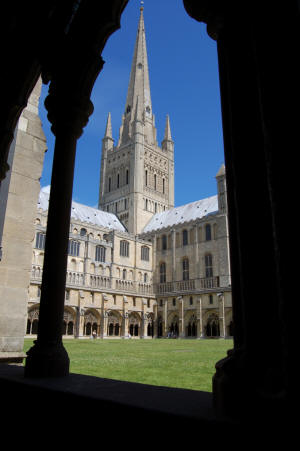|

Norwich Cathedral from the cloisters
Norwich is a medieval city and the
capital of Norfolk and has always been the main
commercial centre of the county. Originally its wealth
was built on wool and weaving but today it has many
modern businesses
- particularly in the financial services sector.
Up until the 19th Century Norwich was England's second
city - however its influence declined with the advent of
the Industrial Revolution. Historically,
Norwich has always looked towards Europe due to poor
transport links with London. During the 16th Century
Flemish refugees - known locally as the 'Strangers' -
moved to Norwich to avoid religious persecution and
helped to expand the wool and cloth trade. At one time
40% of the city's population was Dutch, Flemish or
Walloon. Norwich has a wealth of
architectural heritage including: the Castle, the
Cathedral, the Assembly House (a favourite of Pevsner),
Dragon Hall (the oldest surviving merchant's house in
Europe), the Great Hospital and the new Forum which was
designed by Sir Michael Hopkins. Norwich
also boosts the first artistic group to form outside
London - in the shape of the
Norwich School
Painters, the first provincial library (1608), the
first provincial newspaper (1701), the first non-denominational cemetery
(the Rosary in Thorpe
Hamlet) and the busiest public library in the country. Norwich has long possessed a reputation as a
non-conformist, radical city where Norfolk's motto 'do
different' has been enthusiastically embraced.
Many talented writers have been born or lived in Norwich
and today the city is regarded as a centre of
excellence for writing. The
University of East Anglia's
MA course in Creative Writing - which was set up by
Malcolm Bradbury and Angus Wilson in 1970 - was the first of its kind
in the country and is still thriving today. The UEA also
houses the British Centre for Literary Translation.
In 2012 Norwich became England's first UNESCO City of
Literature.
Famous writers associated with the city include:
|

